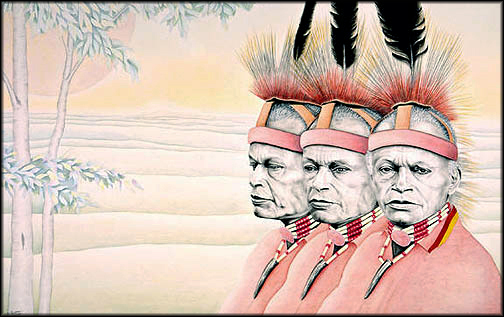“I look at the circle a little differently than other people,” says Little Crow, a Nipmuck from Rhode Island. “To me it’s a church. Before I enter the circle and dance on the grass, I ask for forgiveness. Everything has a spirit. I must respect that if I expect to receive respect in turn. So, before I do anything that might damage the spirit of living things, I ask for forgiveness.”
The traditional homeland of the Nipmuck is central Massachusetts where there is a sacred place – a mountain called Wachusett. In this study of Little Crow, Gerry depicted Mount Wachusett in the distance, as seen from the summit of Mount Monadnock in southern New Hampshire.
Several months before creating his portrait, he spent some time with Little Crow and Chief Spotted Eagle, also a Nipmuck, at the Algonquian Indian School in Rhode Island where he briefly studied their language. Through their conversations, he became aware of the community spirit that was still very much alive there.
The inspiration behind the design of this piece came to him late one night while driving home from an exhibition in New York. “For an instant I had a vision of Little Crow standing before me and as he turned my way, I saw a chronicle of the Nipmuck in his eyes.”
This portrait is thus a brief history of a people seen through the eyes of a single individual. In the profile of Little Crow, he is looking off toward the distant mountain, symbolically looking to his past and affirming his ancestry. The central portrait symbolically represents Nipmuck today, a people in transition between their past and their future. The third portrait represents tomorrow. As a director of the Algonquian Indian School, Little Crow worked to preserve the culture and traditions of the Woodland Indians of Southern New England and to create a better world for his people. His commitment to unite Nipmuck and to establish a place in their traditional homeland for generations to come is unquestioned. He thus plays a vital part in the destiny of his people.
